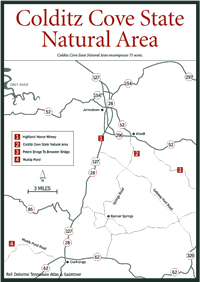
[Fig.
8] Colditz Cove encompasses 75 lush acres, with its principal attraction
being Northrup Falls where Big Branch drops 60 feet in the cove. Northrup Falls
takes its name from the family who lived and worked at the falls. The Northrups
operated a water-powered mill above the horseshoe-shaped cove.

The land was eventually owned by brothers, Arnold and Rudy Colditz. They allowed anyone to walk their land to see Northrup Falls. The Cumberland Mountain Chapter of the Tennessee Trails Association (TTA) asked permission to build trails on their property so people could easily visit the falls. The brothers thought it seemed like a good idea, so in 1984 the TTA built a loop trail around Northrup Falls.
After the TTA invested a good deal of time and money making the area more easily accessible, the Colditz brothers offered to give the land to the state. Initially, the state rejected the extraordinarily lovely area.
The Nature Conservancy accepted the land to hold in trust until something could be worked out so the state would accept it. The state of Tennessee eventually took possession, but TTA's efforts are visible in the small patches of yellow paint with green arrows painted on them pointing the way along the trails.
From the parking area, visitors hike about 0.5 mile down the old roadway before entering the forest. A tall tree canopy allows only dappled sunlight to fall on the trail. Partridge berries, mosses, mushrooms, lady's slippers, and other shade-loving wildflowers grow among the brown evergreen needles on the forest's floor. Mountain laurel and rhododendrons occupy most of the niches available to shrubs. Majestic hemlocks and pine trees provide most of the shade in this pristine forest.
The green arrows lead you around a waterfall loop that is about 1 mile long. The trail splits at the waterfall and hikers can make the circuit in either direction. To the right the trail crosses the small creek by a wooden bridge and follows the sandstone cliffs. There are good views down into the gorge. There are no guard rails at these sites and the rocks are slippery after a heavy dew, rain, or snow, so be careful.
The trail doubles back as it descends into the cove and leads to the waterfall. There are several areas of deeply undercut banks that Indians inhabited. Indians moved into the plateau region about 12,000 years ago and made use of stone shelters among the cliffs close to streams. As they gave up hunting for agriculture, about 3,000 years ago, they moved into the large river valleys.
During the rainy seasons, hikers will have to watch their step crossing shallow patches of running water, and many springs issue from the cliffs. As hikers walk under the cliffs, water will sprinkle on their heads, especially when they reach the area behind the waterfall. The view is beautiful from behind the falls: hikers look across the pool where the water collects from the falls, through the rocks, and into the huge trees and thick lush underbrush.
There are many large, rough boulders that have fallen from the cliff walls to the east of the falls. The trail is sandy as it leaves the falls area to pass down the cove and turn back up to climb to the top of the gorge. Hikers will want to pause, whether they are huffing and puffing from the climb or not, to enjoy the view. It's a short round trip so take your time. Savor the beauty and the serenity of the quiet woods and the vista from Northrup Falls. Colditz Cove is open year-round. There are no facilities and no ranger station.